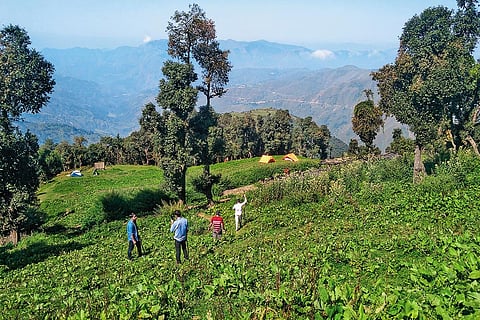
- Destinations
- Experiences
- Stay
- What's new
- Celebrating People
- Responsible Tourism
- CampaignsCampaigns
- Subscribe
- Buy Now

High in the hills of Uttarakhand, in a place called Jardhargaon in the Tehri Garhwal district, a man with wavy white hair lays out parcels of multicoloured seeds, grains, and jewel-like corn in various hues alongside bushy clusters of millets. Perched outside his home, which overlooks the verdant hills of the region, he wears a simple khadi kurta and counts the seeds as he arranges them. Nearby, his grandson plays.
“Where are the jhangora and naurangi?” he murmurs, a hint of urgency in his voice. “I must prepare for the students from Doon University. They are coming to learn about our traditional methods of farming and the art of seed preservation.”
Vijay Jardhari is speaking about an ancient farming practice known as barahnaja (where barah means 12 and anaj means crops). This intercropping method, involving cultivating 12 or more crops, is traditionally practised in the rain-fed regions of Tehri Garhwal.
Reviving the barahnaja method has not been easy. Once the cornerstone of agricultural success in the region, it began to decline in the 1980s. It took years of effort, a grassroots movement, and a lengthy padyatra (foot march) lasting over 50 days to restore this valuable practice.
Jardhari, 73, a soft-spoken resident of Jardhargaon, is a celebrated environmental activist and a leader in India's food sovereignty movement. In his youth, Jardhari was involved in the Chipko Movement, an iconic non-violent socio-ecological initiative launched in the 1970s to protect forests from commercial logging. Inspired by Gandhian philosophy, the movement highlighted the ecological importance of forests as providers and conservers of soil, water, and air.
"We had a popular Chipko slogan that still resonates today: Kya hai jungle ke upkar? Mitti, paani aur beyar—jinda rehne ke aadhar (What are the benefits of the forest? Soil, water, and air. They are the basis of our survival too)."
During this time, Jardhari witnessed the impact of the Green Revolution. “I saw the new seeds, chemical fertilisers, and pesticides that were being introduced. The government and corporations were giving them away for free to entice farmers.”
Initially, crop production rose and was widely celebrated. “But over time, we noticed that the quality of the soil was degrading,” Jardhari explained. These modern methods also eroded farmers' autonomy and led to the loss of traditional seeds. In 1986, he launched the Beej Bachao Andolan (BBA), or "Save the Seeds Movement," to counter these effects. This grassroots initiative focuses on conserving indigenous seeds and promoting traditional farming systems.
“So many farms had switched to the Green Revolution system that we weren’t sure how to begin saving the old ways. My father suggested there must still be remote villages where the Green Revolution hadn’t reached. So, we started travelling, visiting farms to collect and preserve traditional seeds for future use.”
In 1988, Jardhari initiated another padyatra to educate villagers and raise awareness. Joined by old friends from the Chipko Andolan, he journeyed on foot from Arakot in Uttarkashi to Askot in Pithoragarh, distributing seeds and advocating for sustainable farming across the state.
“We found incredible diversity in these hills,” he said. “We discovered over 300 varieties of paddy, traditional wheat, and around 12 types of finger millet.”
Despite initial resistance, Jardhari remained committed to preserving ancient grains and practices. “City folks used to look down on our grains. With the arrival of urban culture, villagers became embarrassed to serve grains like jhangora to guests.”
But the tide began to turn. Indigenous seeds and local foods came to be seen as valuable. “Our critics said we were anti-development, that the world was progressing and we were holding it back. But look at things now,” he says with a smile—referring to the global demand for millets, diverse food systems, and organic, pesticide-free produce.
Jardhari’s approach has been vindicated. Crops like mandwa, jhangora, kauni, and chaulai continue to thrive in his region, proving resilient to droughts and heavy rains.
Still, he is quick to downplay his role.
“I didn’t do anything extraordinary. I just protected an ancient system from market forces. We didn’t rely on NGOs or funding—it was a citizens’ movement. Hum ne logon ko jod ke kiya (We did it by connecting people and communities),” he said.
